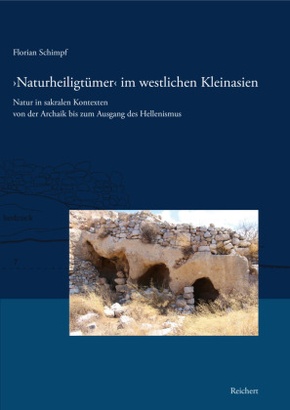'Naturheiligtümer' im westlichen Kleinasien. - Natur in sakralen Kontexten von der Archaik bis zum Ausgang des Hellenismus
| Verlag | Reichert |
| Auflage | 2024 |
| Seiten | 194 |
| Format | 17,6 x 1,5 x 25,0 cm |
| Gewicht | 675 g |
| ISBN-10 | 3752008377 |
| ISBN-13 | 9783752008371 |
| Bestell-Nr | 75200837A |
Heiligtümer waren Orte der Begegnung und Kommunikation mit göttlichen Mächten wie auch des zwischenmenschlichen Austausches. Den kultspezifischen Anforderungen entsprechend kann ihre Gestalt von unscheinbaren Kultplätzen bis hin zu aufwendigen Heiligtümern mit prächtiger, mithin monumentaler Architekturausstattung reichen. Ihre Erforschung nimmt sich gängigerweise einzelner Orte, bestimmter Regionen, ausgewählter Gottheiten, spezifischer Typen oder der Ausstattung und Aspekten der rituellen Praxis an. Die vorliegende Untersuchung ordnet sich insofern in das umrissene Forschungsfeld ein, als sie mit den 'Naturheiligtümern' Westkleinasiens einem bestimmten Typ von Kultstätte gewidmet ist. Dieser Typ zeichnet sich durch eine veritable Naturausstattung, das heißt eine kultplatzprägende Einbeziehung von Felsen, Höhlen, Quellen etc. in den sakralen Raum aus. Ausgehend von 41 Fundplätzen aus archaischer, klassischer und hellenistischer Zeit, die teils erst in den letzten Jahren ausgegrab en und bislang nur in kurzen Grabungsberichten bekannt gemacht worden sind, fragt sie nach dem Vorkommen solcher Kultstätten sowie nach Gemeinsamkeiten/Unterschieden hinsichtlich Lage, Form, Ausstattung, Funktion(en) und Personal. In die Untersuchung einbezogen sind daneben auch solche Heiligtümer, die auf entsprechend 'einfachen' Kultplätzen gründeten, aber im Zuge von Entnaturalisierungs- respektive Monumentalisierungsprozessen in architektonisch determinierte Kontexte einbezogen wurden, sodass die raumkonstitutive Ausgestaltung von Naturformationen mit der Integration von Naturelementen im gebauten Raum kontrastiert und konzeptionell differenziert werden kann. So lässt sich in diachroner Perspektive aufzeigen, wie Natur architektonisch gefasst, überformt oder gar inszeniert wurde. Eine spezifischere Akzentuierung der Untersuchung erfolgt dadurch, dass ein Fokus der Arbeit auf der Frage liegt, wie Natur im rituellen Kontext wahrgenommen wurde. So wird diskutiert, was naturkonsti tutive Elemente wie Bäume, Felsen, Quellen etc. als Bestandteile eines Heiligtums bzw. als Heiligtum qualifizierte und welches ihre Funktion in sakralem Kontext war, ob sie ein Überbleibsel primordialer Gottesdienste darstellten und als intentionaler Rückgriff bzw. -bezug auf eine (mythische) Vergangenheit zu werten sind oder vielmehr rituell bedingt waren und eine veritable Natur- als Alternative zur Architekturausstattung zu bewerten ist.
Caves, rocks, springs and trees shaped ancient cult practice to a great extent and were important, sometimes legitimising components of Greek sanctuaries. They could even constitute the actual sanctuary itself. Since such natural sanctuaries were not per se precursors of later magnificent sanctuaries and an intentional natural decoration is therefore to be understood as an alternative to an architectural decoration, we will discuss what qualified natural constitutive elements as components of a sanctuary or as a sanctuary and what their function was in a sacred context on the basis of Western Asia Minor archaeological sites.

